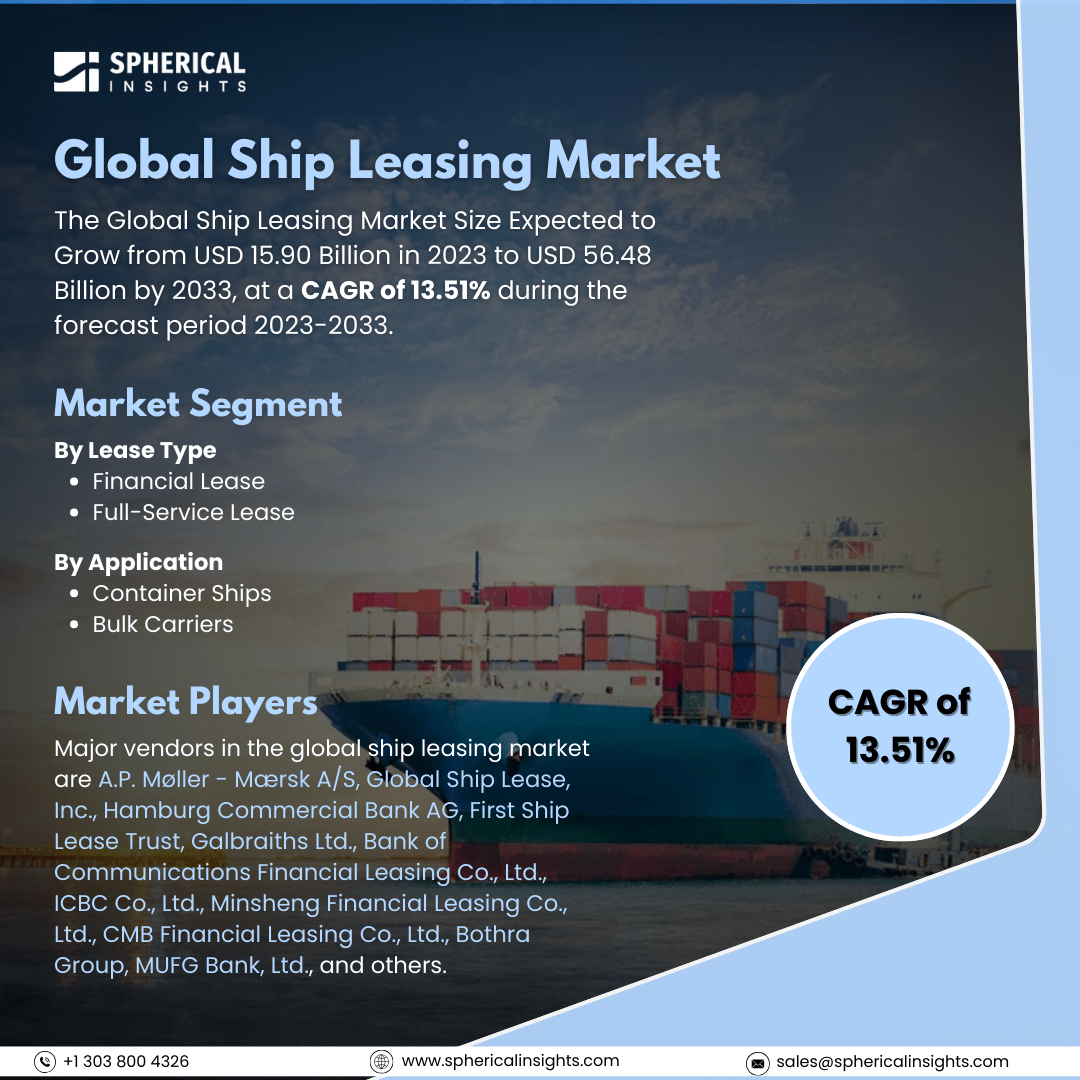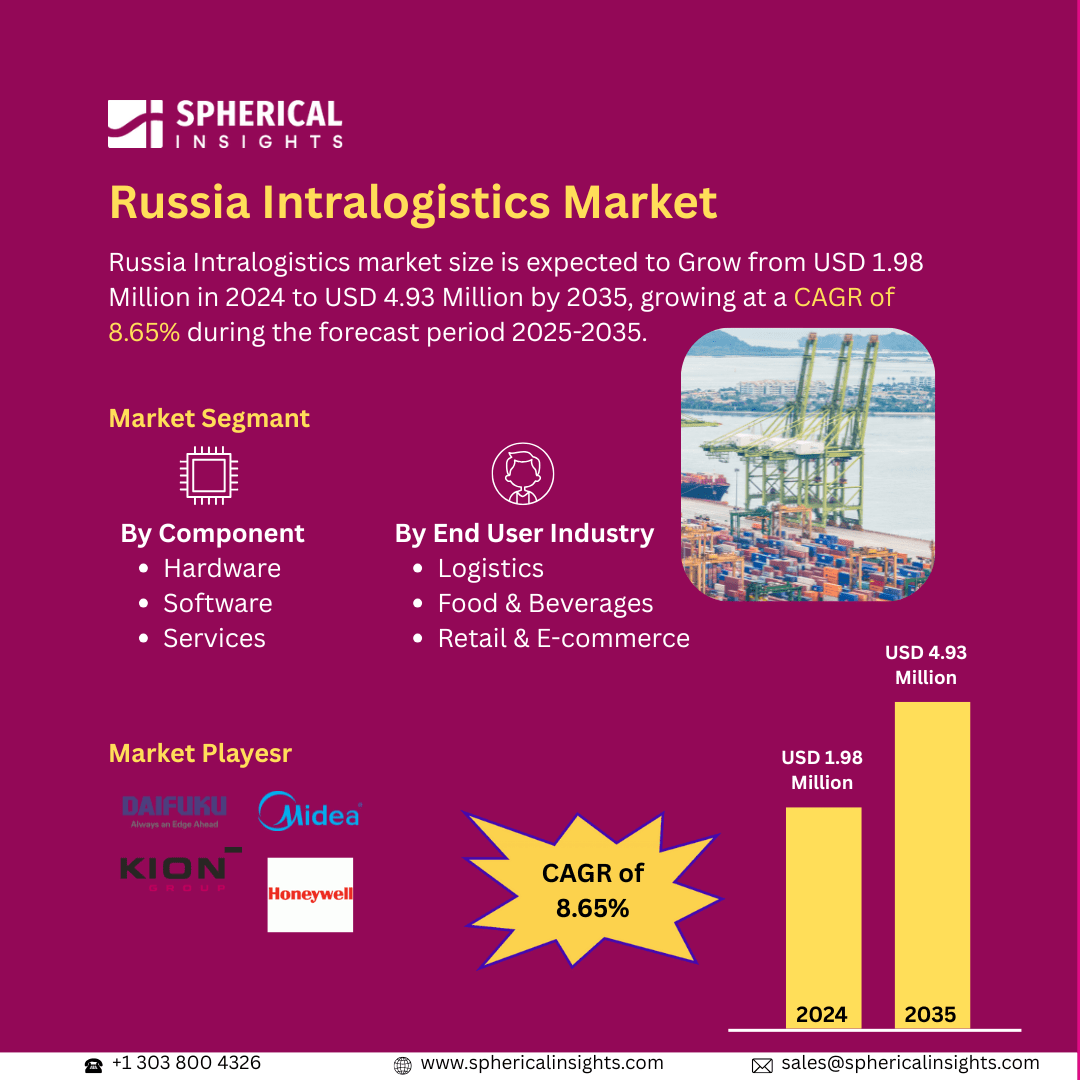Global Ship Leasing Market Size to Exceed USD 56.48 Billion by 2033
According to a research report published by Spherical Insights & Consulting, The Global Ship Leasing Market Size Expected to Grow from USD 15.90 Billion in 2023 to USD 56.48 Billion by 2033, at a CAGR of 13.51% during the forecast period 2023-2033.
Browse 210 market data Tables and 45 Figures spread through 190 Pages and in-depth TOC on the Global Ship Leasing Market Size, Share, and COVID-19 Impact Analysis, By Lease Type (Financial Lease and Full-Service Lease), By Application (Container Ships and Bulk Carriers), and By Region (North America, Europe, Asia Pacific, Latin America, Middle East, and Africa), Analysis and Forecast 2023 – 2033
The ship leasing market is the worldwide business engaged in leasing different kinds of ships, such as cargo vessels, tankers, container vessels, bulk carriers, and offshore support ships, to shipping firms, governments, and other organizations. This market allows lessees to use ships without outright ownership, giving them financial flexibility, cost-effectiveness, and operational scalability in sea transport. Moreover, the ship leasing market is prompted by the high cost of vessel acquisitions, rising global trade, and the necessity of fleet flexibility. High fuel costs and operating costs compel companies towards leasing instead of owning. Increasing demand for container ships, bulk carriers, and offshore support vessels, along with favourable leasing terms offered by financial institutions, contributes to market growth. Maritime legislation and sustainability initiatives further propel leasing in place of new ship acquisition. However, market restraints are characterized by high leasing charges, volatility of freight charges, and economic uncertainty in demand. Stringent maritime legislation, environmental regulatory expenses, and the threat of lessee default also challenge market expansion.
The financial lease segment accounted for the largest share of the global ship leasing market in 2023 and is anticipated to grow at a significant CAGR during the forecast period.
On the basis of lease type, the global ship leasing market is divided into financial lease and full-service lease. Among these, the financial lease segment accounted for the largest share of the global Ship Leasing market in 2023 and is anticipated to grow at a significant CAGR during the forecast period. This is attributed to its long-term cost advantages, ownership transfer facilities, and preference among shipping companies that want asset control without initial investment. Financial leases offer stability and, hence, are the prevalent option for fleet growth and long-term operational planning.
The non-powered respirators segment accounted for a substantial share of the global ship leasing market in 2023 and is anticipated to grow at a rapid pace during the projected period.
On the basis of the application, the global ship leasing market is divided into container ships and bulk carriers. Among these, the non-powered respirators segment accounted for a substantial share of the global ship leasing market in 2023 and is anticipated to grow at a rapid pace during the projected period. This superiority is driven by rising international trade, growth in e-commerce, and high demand for effective cargo shipping. Container ships provide flexibility, quick turnaround, and streamlined logistics, for which reason these are the most sought-after ships to lease in maritime business activities.
Asia Pacific is projected to hold the largest share of the global ship leasing market over the projected period.
Asia Pacific is projected to hold the largest share of the global Ship Leasing market over the projected period. This is driven by the supremacy of China, Japan, and South Korea in maritime trade and shipbuilding. A robust shipping industry, increased import-export transactions, and government encouragement of fleet development helped fuel the growth of the market. Major leasing companies and financial institutions also have extensive activities in the area.
Middle East & Africa is expected to grow at the fastest CAGR of the global ship leasing market during the projected period. This is driven by growing oil and gas exports, higher investments in sea ports, and increasing trade lanes. The Gulf region, notably the UAE and Saudi Arabia, is increasing energy transport leasing of fleets, while African seaports are seeing quick development, creating market expansion.
Company Profiling
Major vendors in the global ship leasing market are A.P. Møller - Mærsk A/S, Global Ship Lease, Inc., Hamburg Commercial Bank AG, First Ship Lease Trust, Galbraiths Ltd., Bank of Communications Financial Leasing Co., Ltd., ICBC Co., Ltd., Minsheng Financial Leasing Co., Ltd., CMB Financial Leasing Co., Ltd., Bothra Group, MUFG Bank, Ltd., and others.
Key Target Audience
- Market Players
- Investors
- End-users
- Government Authorities
- Consulting and Research Firm
- Venture capitalists
- Value-Added Resellers (VARs)
Recent Development
- In October 2023, Global Ship Lease (GSL) entered into an agreement with Ascenz Marorka to deploy its Smart Shipping system on the GSL fleet. According to the terms of the agreement, automatic data collection equipment and software meant to facilitate real-time management and optimization of ship energy consumption and environmental performance (e.g., Ascenz Marorka's weather routing service) would be installed on GSL ships.
Market Segment
This study forecasts revenue at global, regional, and country levels from 2023 to 2033. Spherical Insights has segmented the global ship leasing market based on the below-mentioned segments:
Global Ship Leasing Market, By Lease Type
- Financial Lease
- Full-Service Lease
Global Ship Leasing Market, By Application
- Container Ships
- Bulk Carriers
Global Ship Leasing Market, By Regional
- North America
- Europe
- Germany
- UK
- France
- Italy
- Spain
- Russia
- Rest of Europe
- Asia Pacific
- China
- Japan
- India
- South Korea
- Australia
- Rest of Asia Pacific
- South America
- Brazil
- Argentina
- Rest of South America
- Middle East & Africa
- UAE
- Saudi Arabia
- Qatar
- South Africa
- Rest of the Middle East & Africa



